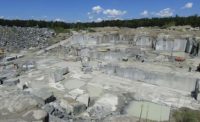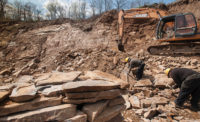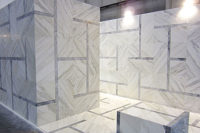The quarry is divided into upper and lower sections — each containing different material with varying characteristics. While stone extracted from the upper area is basalt, the lower area is limestone with deposits of sandstone scattered within.
The basalt located in the upper part of the quarry is defined by a very fine grain, and the material is very white. As the quarry goes deeper into the ground, the stone becomes more pink in color. Additionally, there is also some stone that is light gray in color. The grain of the stone also gets larger as it gets down lower in the quarry.
For the most part, the basalt quarried from the upper level is sold to make cement. The stone is extracted in large blocks — measuring an average of 1.5 x 7 meters.
The limestone found in the lower portion of the quarry is a hard material with a high compressive strength — due to the way it is geologically formed. Moreover, it has a high flexural strength and resistance to salt and harsh weather as well as having low absorption and low porosity.
Equipment used in the quarrying process includes a Fantini chainsaw and Sandvick/Tamrock Ranger SW drill. Vertical cuts are only made with a chainsaw, which moves along the bedding. The block is then moved with an excavator. First, the upper bench is removed followed by the lower bench. Quarry workers do not blast when they are extracting architectural stone. The amount of production depends on the demand. As sections are excavated, they are reclaimed to preserve the natural habitat.
On average, the block size for limestone measures 1.8 x 2.5 meters, and the company strives to attain architectural-sized blocks from the quarry site. Because the process results in a large amount of stone byproducts, all of the stone that is not used for architectural purposes is crushed into three different sizes. Depending on the size, it is used for cement, asphalt and gravel for roadways, or at seaports to prevent erosion.
In addition to quarrying material, Marmi Faedo provides a broad range of services — from offering products that are finished according to the customer’s drawings to technical advice on design and on-site assistance. Among its high-profile finished projects, Marmi Faedo has supplied material for architectural works such as the Sheraton Oran Hotel and Towers in Algeria.











